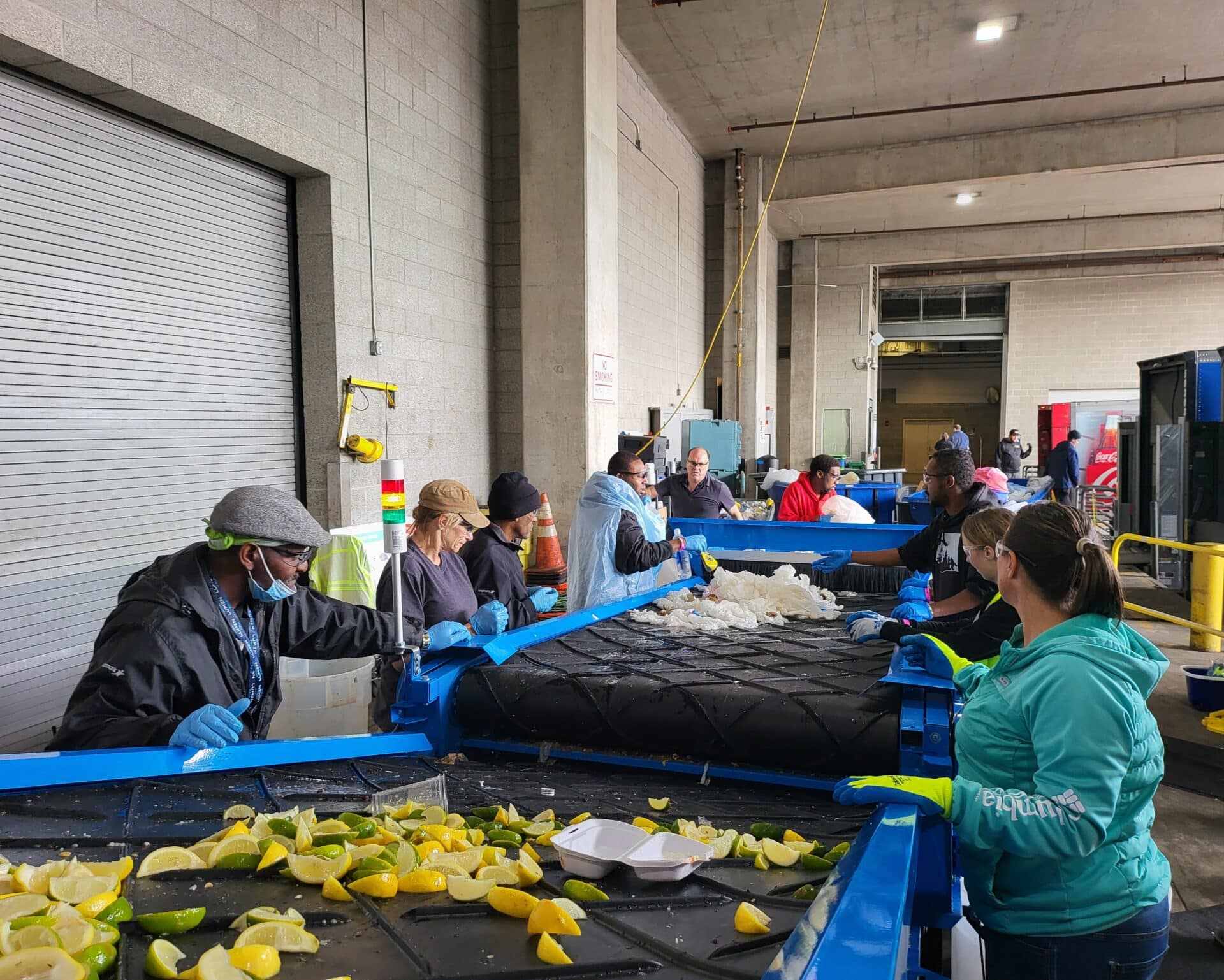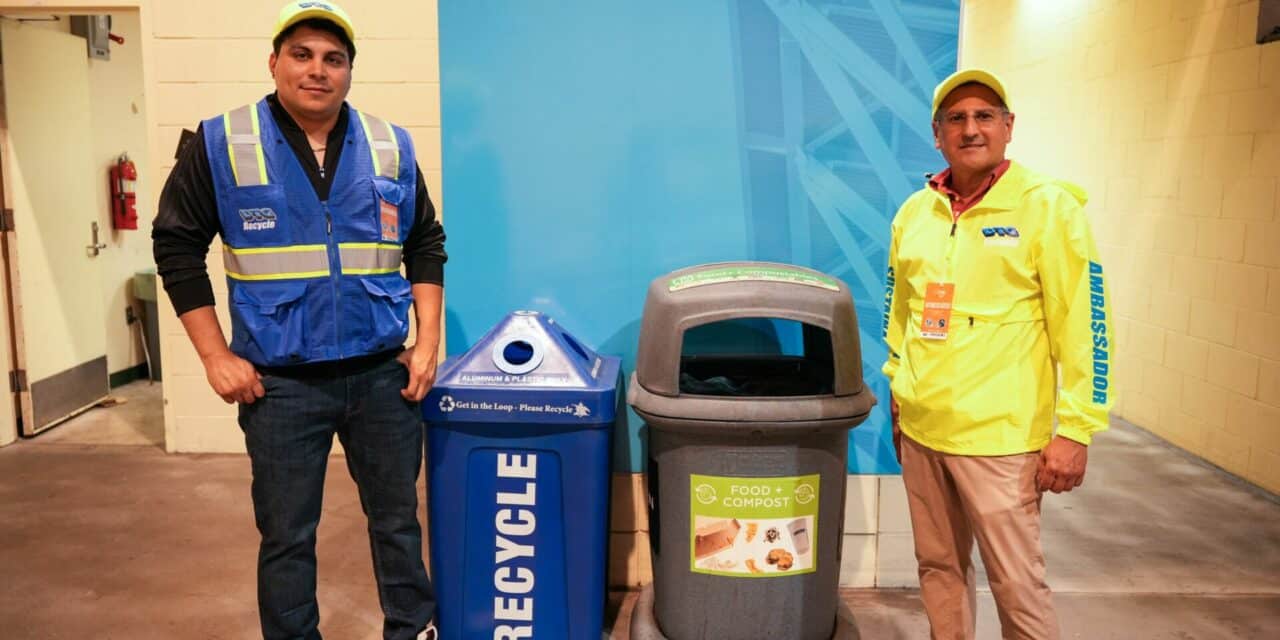TALKING TRASH: The Lumen Field Sustainability Ambassador Program includes partner employees who help fans figure out where to dispose of their trash. (Courtesy venue)
New sponsor helps tackle tough recycling tasks
Lumen Field in Seattle is high in the NFL stadium rankings for diverting waste from the landfill. Staying on top of the heap takes commitment, focus and a winning team.
This week, the Seattle Seahawks announced a new partnership with DTG Recycle to become the proud recycling partner of Lumen Field, the NFL team’s home stadium.
As part of the agreement, the company, which is the largest recycler of industrial, manufacturing, construction and demolition materials in the Pacific Northwest, will manage all traditional recycling and compost for the venue, which has made sustainability a priority since the building opened in 2000.
“Our criteria was finding someone that would dig in and help us be zero waste and be a partner,” said Christy Briggs, sustainability manager for Lumen Field. “We want to reduce, reuse and recycle. Reducing with the capacity we have in our building is not something that is the easiest to do, so we have to look at that recycle piece.”
DTG Recycle will also aid with education, supplying 20 ambassadors to help guests at events and on Seahawks game days to select the right receptacle to discard waste. The goal of the Lumen Field Sustainability Ambassador Program is to make sustainability more convenient, accessible and pleasant for people attending events at Lumen Field, which has a capacity of 68,700 for Seahawks games.

Christy Briggs, sustainability manager for Lumen Field.
Lumen Field has both recycling and composting bins throughout the stadium.
“My philosophy all along has been that the simpler we can make it in venue is going to make it better for all of us, which is why we have a two-bin —not three- or four-bin — system on our concourses,” Briggs said. “Simplifying it helps the fans just enjoy the experience of the game, which is why they come to our facility.”
As part of the team’s sustainability efforts, DTG Recycle will work with operations staff at both Lumen Field and the team’s practice facility, Virginia Mason Athletic Center, to source recycling options for hard to recycle materials such as electronic waste, styrofoam, broken equipment and hard-to-recycle plastics.
“DTG stood out as wanting to really find ways to recycle the hard recyclables,” Briggs said.
An example of a material DTG Recycle was willing to take was the sheets of Visqueen plastic used to cover the stands and the infield for special events such as Super Cross and Monster Jam, which bringin tons of dirt.
“That kind of plastic, that thin film plastic, is a harder commodity to recycle in your regular bin,” Briggs said. “Not only is it harder to recycle, you add on dirt and mud.”
DTG Recycle accepted the challenge, and this year, diverted 17 tons of Visqueen plastic from the landfill. Recently, the company removed 70 hard plastic waste cans days before gameday.
“This is key for us because a lot of times, these things come up in the midst of multiple events when we don’t have a lot of space to store waste,” said Briggs, confirming a challenge familiar to most venue operators.
The Seahawks and Lumen Field continue to make good on their commitment to sustainability, working toward a closed-loop recycling program that diverts more than 90% of stadium waste from the landfill.
During the field replacement at Lumen Field in 2019, 488 tons of rubber and sand were recycled, and the carpet itself was repurposed to ensure that 100% of the project was diverted from the landfill.
The Seahawks and Lumen Field were founding members of the Green Sports Alliance, and a founding partner of Play To Zero, a recognition and sustainability performance tool kit powered by Arc Skoru Inc., in collaboration with the Green Sports Alliance.

Using MRFI sorting technology, seven to eight tons of waste can be sorted in 36 hours, rather than the usual five days.
The Lumen Field stadium complex extends to the WAMU Theater and Lumen Field Event Center, a 325,000 square foot conference facility.
The complex hosts 300 event days a year attracting 2.4 million visitors. The downtown campus has received numerous accolades. including teh 2018 Stadium Business Summit International “Sustainability and Community” Award; 2018 Environmental Protection Agency “Waste Wise” Award’ and the 2020 Environmental Protection Agency “Very Large Business Partner of the Year.”
Other sports and entertainment venues are paying attention and seeking advice as they launch similar initiatives.
“Start small,” recommended Briggs, who serves on the Green Sports Alliance board. “You can make a change and sometimes that means looking in your community and seeing if you can leverage the size of your facility and the amount of waste produced to push for better recycling, for getting commercial composting into the area around the facility. I recommend starting small and don’t try to compare with where we are, or some of the other top diversion facilities, within the first year , because you’re not going to do it and you’re going to frustrate yourself.”
Briggs said everyone hits “snags,” but successful sustainability programs play long ball with buy-in from the entire organization and vendors, including food & beverage, housekeeping and event operations. Briggs said at Lumen Field, they use a working group with representation from all departments to identify priorities and find solutions.
When they encounter challenges, Briggs said they analyze at technology and automation to move forward. Recently, MRFi was the answer with a conveyor belt for sorting waste.
“It has sped our sort time from five days to 36 hours,” Briggs remarked. “Within 36 hours, we are able to hand sort all the waste coming out of our building and get it off property.”
That amount is eight to 10 tons of compost and an additional five to eight tons of recycling at an average Seahawks game.
“We sort in the back of house so fans don’t have to think about it front of house,” Briggs explained. “But if each one of the 2.4 million who come through our building changed one habit because they learned something, either through social media or what they saw at our facility, it would make an exponentially larger impact on our environment than anything we do in the building.”







